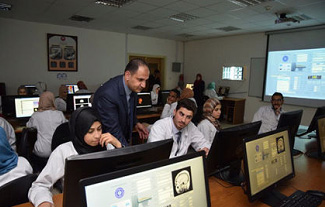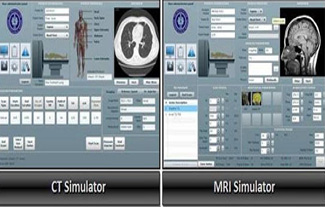1- Radiation Physics Labs
The aim of the radiation physics laboratory is to study the interaction of charged particles and electromagnetic radiation with matter and also to study the important factors affecting the photon interactions including the incident photon energy, the density thickness and the atomic number of the medium.
The experiments in this lab have been tested with GM tubes of different sensitive volumes and NaI (Tl) scintillation detector with integrated computer spectrometer system. Experiments provide a traditional introduction to radiation physics emphasizing a study of the detectors properties plateau, characteristics counting statistics, GM dead time, detector efficiencies, absorbed dose rate, absolute activity and the end point energy of beta particles in Aluminum. Absorption of Gamma rays by different materials, the mass absorption coefficient and the half value thickness have been measured in this lab.
Small sets of commercially available Alpha, Beta and Gamma radioactive sources are used to complete most of these experiments. Studies of Gamma ray energy spectra of Cs-137 and Co-60 sources, energy calibration and energy resolution of NaI (TI) detector using spectrometry system are all performed in this lab.

2- Radiographic Processing & Exposure lab
The goal of this laboratory is to study the effect of exposure technique factors (kVp, mAs and source-to-image distance) on the image quality factors such as contrast, optical density, resolution, sharpness and distortion. X-ray unit and optical densitometer have been used to study the characteristic curve, inverse square law and reciprocity law of the radiographic films exposed to X-rays.
This laboratory also describes the formation of a latent image when radiographic films are exposed to X-rays and processed manually.
Absorption and scattering of X-rays and the characteristic X-ray wavelength of K- alpha and K-beta lines have been measured by Bragg’s method using an X-ray spectrometer.
3 -Image Quality Control lab
The goal of this laboratory is to study the main theoretical aspects of quality control procedures for radiographic equipment and film processing which include x-ray equipment, photographic condensers, x-ray filming and processing.
4- Quantitative Image Analysis lab
The university established a new lab for image processing and analysis. , this lab allows the students to use different medical images to derive different quantitative measures using different imaging softwares. The lab is also used to teach different courses such as the cross-sectional anatomy, and digital imaging courses.

5- Computed Tomography (CT) and MRI Labs
The university purchased CT and MRI simulators which are programs used to simulate CT and MRI devices in hospitals. as the students are trained to use them before the actual practical training in hospitals.
